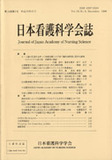Japanese
English
- 販売していません
- Abstract 文献概要
- 参考文献 Reference
要旨
産褥期の養育者,特に母親にとっては,子どもとの生活リズムの調整が大きな課題となる.本研究の目的は,生後6週間の正常児の睡眠・覚醒状態を明らかにし,入眠潜時の生理的な変化として足底皮膚温の変化を捉えることである.対象は16名の正常児で,生後2,4,6週目の3時点に家庭訪問をして,児の生理的・行動状態を連続して観察し,以下の結果が得られた.
1.授乳サイクル(授乳開始から次の授乳を開始する前までの時間)を概観し,ひじょうにぐっすり眠る型から,眠らない型の4つのパターンに分類できた.授乳サイクルの平均時間は,ぐっすり眠るパターンの方が次の授乳までの間隔は有意に長くなっていた.
2.睡眠パターンと入眠潜時における皮膚温の変化は,ぐっすり眠ったパターンを示す群では,眠りにつくまでに皮膚温が有意に上昇し,眠らなかったパターンでは皮膚温が下降していた.
母親にとって,この皮膚温の上昇が,新生児の授乳に関連した行動の予測の一助となりうるのではないかと示唆された.
Abstract
Infant sleep pattern is unstable during the early postpartum period. During this period, infant care is difficult for new parents, especially caregivers. The purpose of this study was to examine whether the skin temperature of newborns could be used to predict sleep patterns during the first six weeks of life.
The subjects were 16 healthy, full term infants (7 males and 9 females), who had no neurological or developmental problems. The infants were observed sleep-wake states, behaviors, and skin temperatures of the sole, which were monitored every minute. The sleep-wake states were adopted from Brazelton's 6 classifications. Skin temperatures were monitored by a probe, the Skin Temperature CTM-303 (TERUMO Co.). All data were collected by a single observer (E. H.). At two, four, and six weeks, infants were observed at their home during the day between 10:00 AM and 3:00 PM. Sleep data were analyzed according to each infant's feeding pattern as feeding and sleep are closely related.“Feeding-cycle”was defined as the sequence of time from when the mother began to feed her baby until the time immediately before the next feeding. 133“feeding-cycles”were observed.
In conclusion, 4 types of sleep-wake patterns were observed in the newborns: Type 1: falling into deep sleeps (More than two periods of quiet sleep), Type 2: falling into a deep sleep (One period of quiet sleep), Type 3: Shallow sleep (Active sleep), Type 4: wakefulness. Each infant demonstrated various sleep-wake patterns. Type 1 was the longest period of sleep. Types 1 and 2 were significantly longer than Types 3 and 4. While each newborn slept in various patterns, the skin temperatures of newborns increased by.3 to. 4°C before they took long naps. Further researches are indicated as to how mothers can detect these temperature changes so that the information will facilitate new mothers to adjust to the new life styles.
Copyright © 1998, Japan Academy of Nursing Science. All rights reserved.


